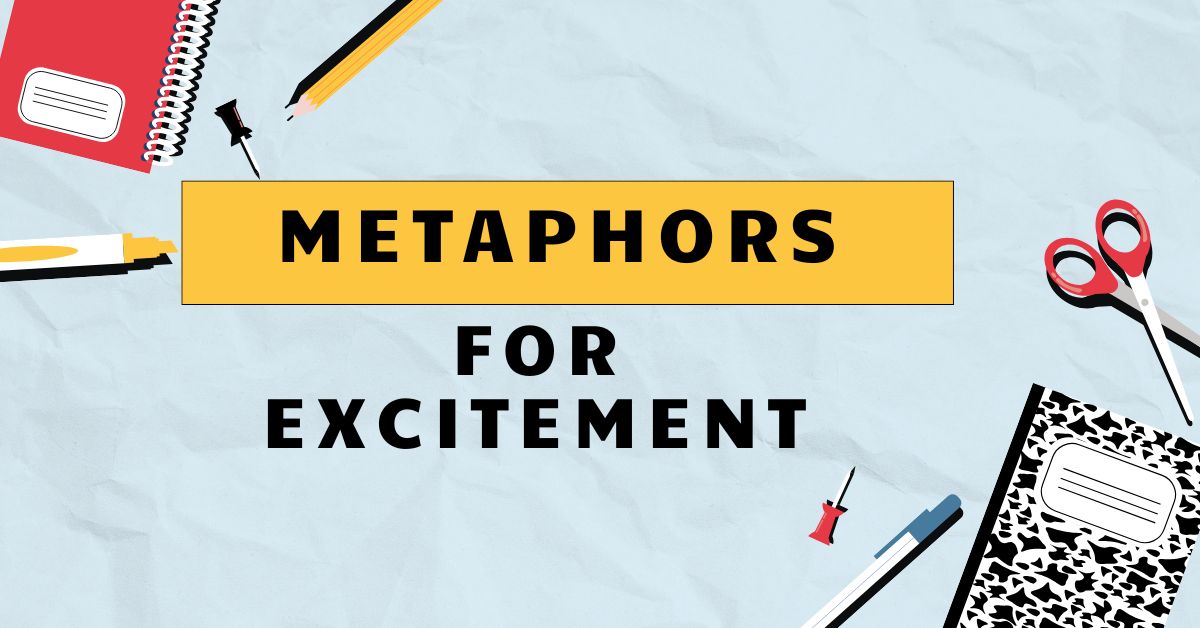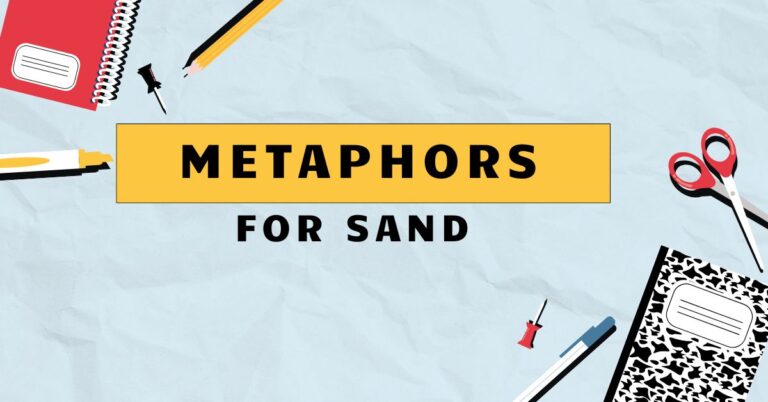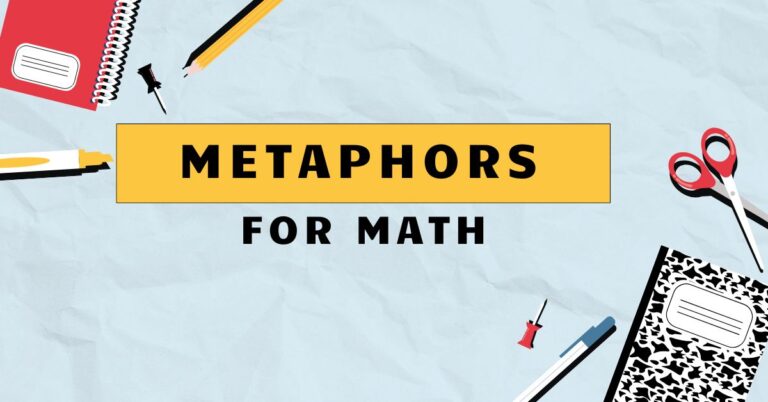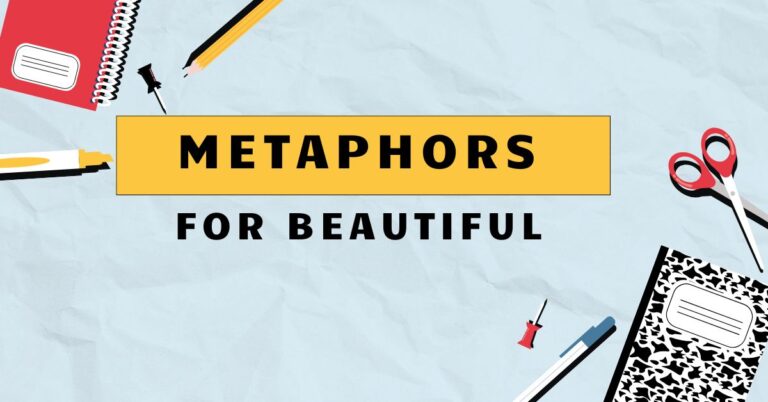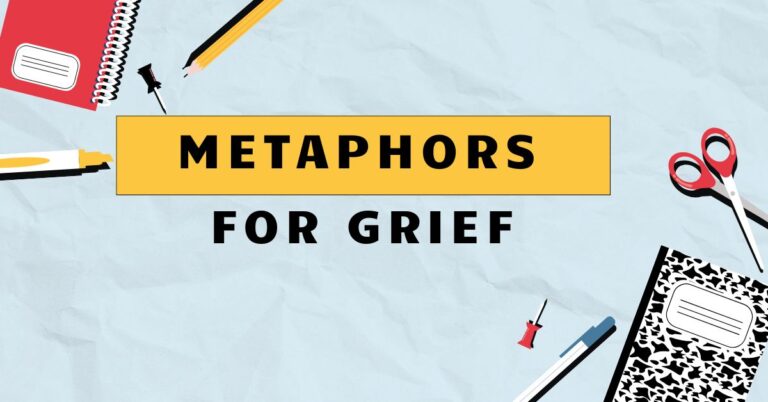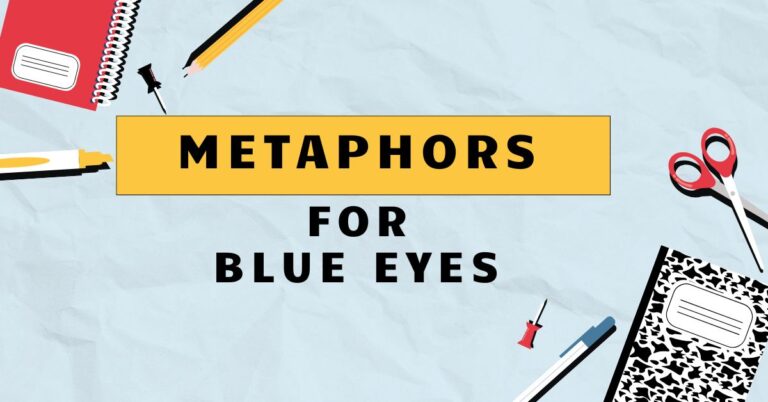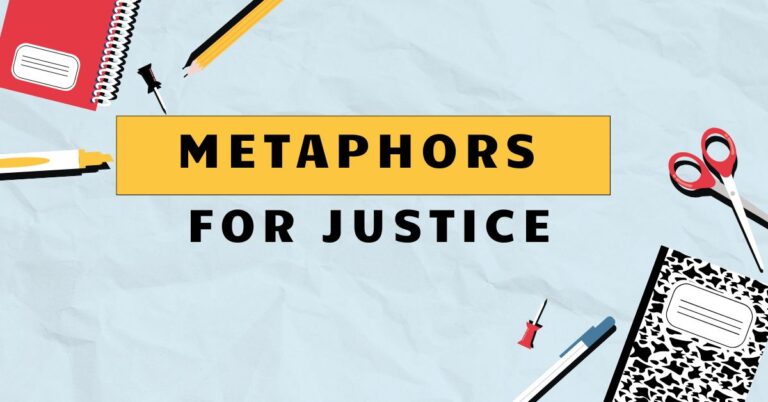38 Metaphors for Excitement: A Comprehensive Guide
Excitement, that exhilarating rush of emotion, is a fundamental human experience. Yet, capturing its essence in words can be challenging.
This is where metaphors step in, transforming abstract feelings into vivid, relatable images. Understanding metaphors for excitement not only enriches your vocabulary but also deepens your comprehension of figurative language and enhances your ability to express yourself with flair.
This article provides a comprehensive exploration of metaphors used to describe excitement, suitable for English language learners of all levels, writers seeking to inject vibrancy into their prose, and anyone curious about the power of metaphorical expression.
Table of Contents
- Introduction
- Definition of Metaphor and Excitement
- Structural Breakdown
- Types and Categories of Excitement Metaphors
- Examples of Metaphors for Excitement
- Usage Rules for Metaphors
- Common Mistakes When Using Metaphors
- Practice Exercises
- Advanced Topics
- Frequently Asked Questions
- Conclusion
Definition of Metaphor and Excitement
To fully grasp the power and application of metaphors for excitement, it’s crucial to understand the core definitions of both metaphors and excitement, as well as how they interact to create vivid and impactful language.
What is a Metaphor?
Ametaphoris a figure of speech that directly compares two unrelated things, asserting that one thingisanother. Unlike similes, which use words like “like” or “as” to make a comparison, metaphors make a direct equation.
The purpose of a metaphor is to transfer qualities or characteristics from one concept (the source) to another (the target), enriching the understanding of the target concept. For instance, saying “He is a lion in battle” doesn’t mean he is literally a lion, but rather that he possesses the courage, strength, and ferocity associated with lions.
Metaphors are a fundamental aspect of human cognition, shaping how we understand and communicate about the world. They allow us to grasp abstract concepts by relating them to more concrete or familiar experiences.
This makes complex ideas more accessible and memorable. Metaphors can be found in everyday language, literature, and even scientific discourse, highlighting their pervasive influence on human thought and expression.
Defining Excitement
Excitementis an emotional state characterized by feelings of enthusiasm, eagerness, and anticipation. It is often accompanied by physical sensations such as increased heart rate, heightened alertness, and a sense of exhilaration.
Excitement can be triggered by a variety of stimuli, including positive news, thrilling experiences, or the anticipation of something pleasurable. It is a powerful motivator, driving us to pursue goals, explore new possibilities, and engage with the world around us.
Excitement can range from mild anticipation to intense exhilaration, reflecting its multifaceted nature.
Psychologically, excitement is linked to the release of neurotransmitters like dopamine and adrenaline, which contribute to the feelings of pleasure and heightened arousal. This physiological response reinforces the emotional experience, making excitement a potent and memorable state.
The intensity and duration of excitement can vary depending on the individual, the situation, and the personal significance of the event or anticipation. Understanding the underlying mechanisms of excitement helps to appreciate the diverse ways in which it can be expressed and experienced.
Function of Metaphors for Excitement
Metaphors play a crucial role in articulating the subjective experience of excitement. Because excitement is an internal emotional state, it can be difficult to describe directly.
Metaphors provide a way to externalize and communicate these feelings by associating them with tangible, relatable concepts. By using metaphors, we can convey the intensity, quality, and impact of excitement in a way that resonates with others.
For example, saying “She was buzzing with excitement” uses the image of a buzzing insect to convey a sense of restless energy and anticipation.
The function of metaphors for excitement extends beyond mere description. They can also evoke emotional responses in the reader or listener, allowing them to vicariously experience the feeling of excitement.
A well-chosen metaphor can amplify the impact of a narrative, making it more engaging and memorable. Furthermore, metaphors can reveal deeper insights into the nature of excitement, highlighting its various facets and nuances.
They offer a creative and expressive means of capturing the multifaceted nature of this powerful emotion.
Contexts for Using Excitement Metaphors
The use of metaphors for excitement is appropriate in a wide range of contexts, from informal conversations to formal writing. In everyday speech, we often use metaphors to express our feelings in a vivid and relatable way.
For example, we might say “I’m on cloud nine!” to express extreme happiness and excitement. In creative writing, metaphors can be used to create atmosphere, develop characters, and enhance the overall impact of the narrative.
Authors often employ metaphors to convey the internal emotional states of their characters, making them more believable and relatable.
In professional settings, metaphors can be used to communicate enthusiasm and inspire action. For example, a motivational speaker might use metaphors to energize their audience and encourage them to pursue their goals with passion.
However, it’s important to use metaphors judiciously in formal contexts, ensuring that they are appropriate for the audience and the message being conveyed. Overuse of metaphors can detract from the clarity and professionalism of the communication.
Therefore, careful consideration should be given to the context and purpose of the communication when employing metaphors for excitement.
Structural Breakdown
Understanding the structure of metaphors is essential for both interpreting and creating them effectively. Each metaphor consists of two key components: the source domain and the target domain.
The relationship between these domains, known as mapping, is what gives the metaphor its meaning and power.
Source Domain
Thesource domainis the conceptual area from which the metaphorical expression is drawn. It is typically a concrete or familiar concept that is used to describe something more abstract.
In the context of excitement metaphors, common source domains include physical sensations, speed and movement, light and energy, explosions, and animalistic behaviors. For example, in the metaphor “Her heart was racing with excitement,” the source domain is physical sensation (racing heart).
The choice of source domain is crucial in determining the effectiveness of a metaphor. A well-chosen source domain should be readily accessible and easily understood by the target audience.
It should also possess qualities or characteristics that are relevant to the target domain. By carefully selecting the source domain, a writer can create a metaphor that is both vivid and meaningful, effectively conveying the intended message.
Target Domain
Thetarget domainis the abstract concept that is being described or explained through the metaphor. In the case of excitement metaphors, the target domain is the emotional state of excitement itself.
Because excitement is an internal and subjective experience, it can be challenging to describe directly. Metaphors provide a way to make this abstract concept more concrete and relatable by associating it with familiar experiences from the source domain.
The target domain is enriched by the qualities and characteristics that are transferred from the source domain. For example, when we say “He was bursting with excitement,” we are using the source domain of explosion to convey the intensity and overflowing nature of his excitement.
The target domain of excitement is thus understood as something that can build up pressure and release suddenly, similar to an explosion.
Mapping
Mappingrefers to the process of connecting elements from the source domain to corresponding elements in the target domain. It involves identifying the specific qualities or characteristics that are being transferred from one concept to another.
For example, in the metaphor “She was on fire with excitement,” the mapping involves connecting the heat and energy associated with fire (source domain) to the intensity and passion of her excitement (target domain).
Effective mapping is crucial for creating a coherent and meaningful metaphor. The connections between the source and target domains should be logical and intuitive, allowing the audience to easily grasp the intended meaning.
If the mapping is unclear or inconsistent, the metaphor may be confusing or ineffective. Therefore, careful attention should be paid to the mapping process when constructing and interpreting metaphors.
Types and Categories of Excitement Metaphors
Metaphors for excitement can be categorized based on the source domain from which they are derived. These categories provide a framework for understanding the different ways in which excitement can be expressed metaphorically.
Physical Sensation Metaphors
These metaphors describe excitement in terms of physical sensations experienced by the body. They often involve heightened awareness, increased heart rate, or other physiological responses associated with excitement.
Examples include “Her heart pounded with excitement” and “He felt a jolt of excitement.” These metaphors emphasize the embodied nature of excitement, highlighting the physical impact of the emotion.
Physical sensation metaphors are particularly effective because they tap into our shared human experiences. Everyone can relate to the feeling of a racing heart or a surge of adrenaline.
By using these metaphors, writers can create a visceral and relatable portrayal of excitement, allowing the audience to feel the emotion alongside the character.
Speed and Movement Metaphors
These metaphors associate excitement with rapid motion or acceleration. They often involve images of running, flying, or spinning.
Examples include “He was swept away by excitement” and “She raced towards the opportunity with excitement.” These metaphors convey the sense of energy and momentum that often accompanies excitement.
Speed and movement metaphors are particularly useful for describing situations where excitement leads to action or a desire to move forward. They capture the feeling of being propelled by enthusiasm and the eagerness to embrace new possibilities.
These metaphors can also create a sense of urgency and anticipation, heightening the emotional impact of the narrative.
Light and Energy Metaphors
These metaphors describe excitement in terms of brightness, illumination, or intense energy. They often involve images of light bulbs, stars, or electricity.
Examples include “Her eyes sparkled with excitement” and “He radiated excitement.” These metaphors emphasize the illuminating and invigorating qualities of excitement.
Light and energy metaphors are particularly effective for conveying the transformative power of excitement. They suggest that excitement can brighten one’s perspective, energize one’s actions, and illuminate new possibilities.
These metaphors can also create a sense of optimism and hope, highlighting the positive impact of excitement on one’s outlook.
Explosive Metaphors
These metaphors portray excitement as a sudden, powerful release of energy, similar to an explosion. Examples include “He was bursting with excitement” and “She erupted with excitement.” These metaphors emphasize the overwhelming and often uncontrollable nature of intense excitement.
Explosive metaphors are particularly useful for describing situations where excitement reaches a peak and is expressed outwardly. They capture the feeling of being overwhelmed by emotion and the urge to express it in a dramatic way.
These metaphors can also create a sense of surprise and intensity, heightening the emotional impact of the narrative.
Animalistic Metaphors
These metaphors associate excitement with the behaviors or characteristics of animals. Examples include “He was jumping for joy like a puppy” and “She purred with excitement.” These metaphors often emphasize the unrestrained and instinctive nature of excitement.
Animalistic metaphors can be particularly effective for conveying the raw and primal aspects of excitement. They tap into our innate understanding of animal behavior and allow us to connect with the emotion on a more visceral level.
These metaphors can also create a sense of playfulness and spontaneity, highlighting the joyful and carefree nature of excitement.
Examples of Metaphors for Excitement
To illustrate the different types of excitement metaphors, here are several examples organized by category. Each example demonstrates how a particular source domain is used to describe the target domain of excitement.
Physical Sensation Metaphors Examples
The following table provides examples of metaphors that use physical sensations to describe excitement.
| Metaphor | Explanation |
|---|---|
| Her heart pounded with excitement. | Describes the feeling of a racing heart due to excitement. |
| He felt a jolt of excitement. | Conveys a sudden surge of excitement. |
| A shiver of excitement ran down her spine. | Describes a physical sensation of excitement. |
| His palms were sweating with excitement. | Highlights the physical nervousness associated with excitement. |
| She felt butterflies in her stomach with excitement. | A common metaphor for nervousness and anticipation. |
| The news sent a tingle of excitement through him. | A subtle physical sensation indicating excitement. |
| Her breath hitched with excitement. | Describes a physical reaction to surprising excitement. |
| He felt a rush of adrenaline with pure excitement. | Connects the physical response of adrenaline to excitement. |
| Her skin tingled with anticipation and excitement. | Describes excitement as a noticeable physical sensation. |
| His blood coursed faster with excitement. | Portrays excitement as quickening the bloodstream. |
| She felt a wave of excitement wash over her. | Describes an overwhelming physical sensation of excitement. |
| His muscles tensed with excitement. | Highlights the physical tension associated with anticipation. |
| She felt a warm glow of excitement spreading through her chest. | Describes excitement as a comforting physical sensation. |
| He felt a knot of excitement in his stomach. | Describes the nervous anticipation associated with excitement. |
| Her face flushed with excitement. | Connects excitement to a visible physical reaction. |
| She felt a surge of energy and excitement coursing through her veins. | Describes excitement as a physical boost of energy. |
| His pulse quickened with excitement. | Highlights the physical impact of excitement on heart rate. |
| She felt a buzz of excitement throughout her body. | Describes excitement as an electrifying physical sensation. |
| He felt a thrill of excitement. | Describes excitement as an intense physical sensation. |
| Her heart skipped a beat with excitement. | Describes excitement as a surprising physical sensation. |
| A tremor of excitement passed through her. | Describes excitement as a subtle physical sensation. |
| He felt a lightness in his chest with excitement. | Describes excitement as a freeing physical sensation. |
| She felt a spark of excitement ignite within her. | Connects excitement to a burst of physical energy. |
| His head swam with excitement. | Describes excitement as a disorienting physical sensation. |
| She felt a surge of warmth and excitement. | Describes excitement as a comforting physical sensation. |
| He felt a flutter of excitement in his chest. | Describes excitement as a gentle physical sensation. |
| Her body vibrated with excitement. | Describes excitement as a palpable physical sensation. |
Speed and Movement Metaphors Examples
The following table provides examples of metaphors that use speed and movement to describe excitement.
| Metaphor | Explanation |
|---|---|
| He was swept away by excitement. | Conveys the feeling of being overwhelmed by excitement. |
| She raced towards the opportunity with excitement. | Describes the eagerness to pursue something exciting. |
| The news sent him spinning with excitement. | Conveys a sense of disorientation and joy. |
| She was carried away on a wave of excitement. | Describes being transported by a feeling of excitement. |
| He jumped for joy with excitement. | A classic metaphor for expressing happiness and excitement. |
| Her mind was racing with exciting thoughts. | Describes the speed of thoughts during excitement. |
| He was propelled forward by excitement. | Describes excitement as a driving force. |
| She flew through her tasks with excitement. | Describes excitement as boosting productivity. |
| He zoomed through the day with excitement. | Describes excitement as making the day pass quickly. |
| She danced with excitement. | Describes excitement as leading to joyful movement. |
| He bounded up the stairs with excitement. | Describes excitement as energizing movement. |
| She was swept off her feet with excitement. | Describes excitement as an overwhelming force. |
| He sprinted towards his dreams with excitement. | Describes excitement as fueling ambition. |
| She accelerated towards the goal with excitement. | Describes excitement as increasing momentum. |
| He was launched into a new adventure with excitement. | Describes excitement as initiating a new phase. |
| She navigated the challenge with excitement. | Describes excitement as making tasks more engaging. |
| He surfed the wave of excitement. | Describes excitement as a thrilling ride. |
| She skipped down the path with excitement. | Describes excitement as leading to lighthearted movement. |
| He floated on a cloud of excitement. | Captures the feeling of being uplifted by excitement. |
| She glided through the evening with excitement. | Describes excitement as making everything flow smoothly. |
| He rocketed to success with excitement. | Describes excitement as fueling rapid achievement. |
| She swung from the chandeliers with excitement. | Describes excitement as leading to unrestrained behavior. |
| He cartwheeled with excitement. | Describes excitement as prompting playful movement. |
| She pirouetted with excitement. | Describes excitement as inspiring graceful movement. |
| He leaped into action with excitement. | Describes excitement as initiating quick responses. |
| She climbed the ladder of success with excitement. | Describes excitement as making progress more enjoyable. |
Light and Energy Metaphors Examples
The following table provides examples of metaphors that use light and energy to describe excitement.
| Metaphor | Explanation |
|---|---|
| Her eyes sparkled with excitement. | Conveys the brightness and liveliness associated with excitement. |
| He radiated excitement. | Describes excitement as an outward glow. |
| She was illuminated with excitement. | Describes excitement as bringing clarity and joy. |
| He was electrified with excitement. | Conveys a sense of intense energy and stimulation. |
| Her face lit up with excitement. | A common metaphor for expressing joy and enthusiasm. |
| He was a beacon of excitement. | Describes excitement as being infectious and inspiring. |
| She glowed with excitement. | Describes excitement as a warm and radiant feeling. |
| He buzzed with energy and excitement. | Describes excitement as a vibrant and active feeling. |
| Her spirit shone with excitement. | Describes excitement as an inner light. |
| He was charged with excitement. | Describes excitement as being full of energy. |
| Her smile was radiant with excitement. | Describes excitement as enhancing beauty. |
| He was a dynamo of excitement. | Describes excitement as a powerful force. |
| She burned with excitement. | Describes excitement as an intense passion. |
| He was a live wire of excitement. | Describes excitement as being unpredictable and energetic. |
| Her laughter was like sunshine, filled with excitement. | Describes laughter as radiant and joyful due to excitement. |
| He was a powerhouse of enthusiasm and excitement. | Describes excitement as a source of strength and energy. |
| She was a firecracker of excitement. | Describes excitement as explosive and vibrant. |
| He was a star shining brightly with excitement. | Describes excitement as a dazzling and prominent quality. |
| Her voice was electric with excitement. | Describes excitement as adding energy to her speech. |
| He was a lightning bolt of excitement. | Describes excitement as sudden and impactful. |
| She was a spark of joy and excitement. | Describes excitement as a small but potent source of happiness. |
| He was a sunbeam of excitement. | Describes excitement as warm, comforting, and joyful. |
| She was a lamp glowing with excitement. | Describes excitement as providing guidance and warmth. |
| He was a torch blazing with excitement. | Describes excitement as a strong and guiding force. |
Explosive Metaphors Examples
The following table provides examples of metaphors that use explosive imagery to describe excitement.
| Metaphor | Explanation |
|---|---|
| He was bursting with excitement. | Conveys the feeling of being overwhelmed by excitement. |
| She erupted with excitement. | Describes a sudden and forceful expression of excitement. |
| His joy exploded with excitement. | Describes an intense and sudden burst of happiness. |
| She detonated with excitement. | Conveys a powerful and uncontrollable expression of excitement. |
| He was ready to blow with excitement. | Describes the buildup of intense anticipation. |
| Her enthusiasm ignited like dynamite with excitement. | Describes excitement as a rapid and powerful ignition. |
| He felt like a volcano about to erupt with excitement. | Describes excitement as a growing and irresistible force. |
| She was a geyser of excitement. | Describes excitement as a sudden and powerful release. |
| His anticipation reached critical mass with excitement. | Describes excitement as reaching a peak point. |
| She was a champagne bottle about to pop with excitement. | Describes excitement as a festive and joyful release. |
| He was a powder keg of excitement. | Describes excitement as a dangerous and volatile force. |
| She was a firework of excitement. | Describes excitement as bright, colorful, and fleeting. |
| His emotions detonated with excitement. | Describes a sudden and intense release of feelings. |
| She was a pressure cooker ready to explode with excitement. | Describes the buildup of intense anticipation. |
| He was a bomb of excitement. | Describes excitement as a powerful and impactful force. |
| Her happiness burst like fireworks with excitement. | Describes a sudden and spectacular display of joy. |
| He was a rocket launching with excitement. | Describes excitement as propelling him forward. |
| She was a supernova of excitement. | Describes excitement as an extraordinarily bright and powerful event. |
Animalistic Metaphors Examples
The following table provides examples of metaphors that use animalistic behaviors to describe excitement.
| Metaphor | Explanation |
|---|---|
| He was jumping for joy like a puppy. | Conveys unrestrained happiness and excitement. |
| She purred with excitement. | Describes a soft, contented expression of excitement. |
| He wagged his tail with excitement. | Describes a physical display of happiness and enthusiasm. |
| She chirped with excitement. | Describes a light and cheerful expression of excitement. |
| He roared with excitement. | Describes a loud and powerful expression of excitement. |
| She fluttered with excitement like a hummingbird. | Describes a delicate and energetic expression of excitement. |
| He pounced on the opportunity with excitement like a lion. | Describes an aggressive and eager pursuit of something exciting. |
| She danced with excitement like a butterfly. | Describes a graceful and joyful expression of excitement. |
| He grinned like a Cheshire cat with excitement. | Describes a wide and mischievous expression of happiness. |
| She hopped with excitement like a rabbit. | Describes a light and energetic expression of happiness. |
| He pranced with excitement like a stallion. | Describes a proud and energetic expression of happiness. |
| She cooed with excitement like a dove. | Describes a gentle and affectionate expression of happiness. |
| He howled with excitement like a wolf. | Describes a loud and unrestrained expression of happiness. |
| She scampered with excitement like a squirrel. | Describes a quick and playful expression of happiness. |
Usage Rules for Metaphors
While metaphors can greatly enhance your writing, it’s important to use them correctly. Here are some guidelines to follow when using metaphors, particularly those related to excitement.
Appropriateness and Context
Ensure that the metaphor is appropriate for the context and audience. A metaphor that works well in a casual conversation might not be suitable for a formal presentation.
Consider the tone and purpose of your communication when selecting a metaphor. Overly complex or obscure metaphors can confuse or alienate your audience.
Choose metaphors that are easily understood and relevant to the subject matter.
For example, using explosive metaphors might be suitable for describing a rock concert, but inappropriate for a somber memorial service. Consider the emotional impact of your metaphors and ensure that they align with the overall message you are trying to convey.
Originality and Freshness
Strive for originality in your metaphors. While some common metaphors are effective, overused metaphors can become clichés and lose their impact.
Try to create fresh and imaginative metaphors that provide a new perspective on the subject. Think about unique ways to connect the source and target domains, drawing on your own personal experiences and observations.
For example, instead of saying “He was on cloud nine,” you could say “He felt like he was floating among the stars.” The latter metaphor is more original and evocative, creating a stronger impression on the reader.
Consistency
Maintain consistency within a single metaphor. Avoid mixing different elements from unrelated source domains, as this can create a confusing and disjointed image.
Once you have established a particular metaphorical framework, stick to it throughout the passage or text. Inconsistent metaphors can undermine your credibility and weaken the overall impact of your writing.
For example, if you start by describing excitement as a fire, avoid suddenly shifting to metaphors related to water or ice. Stick with the fire metaphor and explore its various aspects to create a cohesive and compelling image.
Avoiding Clichés
One of the biggest pitfalls in using metaphors is relying on clichés. Clichés are overused and predictable metaphors that have lost their impact through repetition.
They often come across as lazy or unoriginal. Avoid common metaphors like “butterflies in my stomach” or “on cloud nine.” These phrases have been used so frequently that they no longer evoke a strong emotional response.
Instead of resorting to clichés, try to create your own unique metaphors that capture the essence of excitement in a fresh and imaginative way. Think about the specific qualities of excitement that you want to convey and explore different source domains that might be relevant.
The more original and creative your metaphors are, the more effective they will be.
Common Mistakes When Using Metaphors
Even experienced writers can make mistakes when using metaphors. Here are some common errors to avoid.
Mixed Metaphors
Amixed metaphoroccurs when two or more inconsistent metaphors are combined in a single statement. This can create a confusing and nonsensical image.
For example, “We need to nip it in the bud before it snowballs into a raging inferno” combines the metaphor of nipping a bud (gardening) with the metaphor of a snowball (winter) and a raging inferno (fire). These metaphors don’t fit together logically and create a disjointed effect.
To avoid mixed metaphors, carefully consider the source domains you are using and ensure that they are compatible. If you are using a metaphor related to nature, stick with other natural elements.
Avoid mixing metaphors from unrelated fields, such as sports and cooking.
Correct: We need to address this issue quickly before it escalates.
Incorrect: We need to nip it in the bud before it snowballs into a raging inferno.
Overused Metaphors
As mentioned earlier, overused metaphors, or clichés, can weaken your writing. These metaphors have lost their impact through repetition and no longer evoke a strong emotional response.
Examples include “butterflies in my stomach,” “on cloud nine,” and “a roller coaster of emotions.” While these metaphors are easily understood, they lack originality and creativity.
To avoid overused metaphors, challenge yourself to come up with fresh and imaginative alternatives. Think about the specific qualities of excitement that you want to convey and explore different source domains that might be relevant.
The more unique and original your metaphors are, the more effective they will be.
Correct: She was thrilled about the upcoming event.
Incorrect: She had butterflies in her stomach about the event.
Inappropriate Tone
Metaphors should be appropriate for the tone and context of your writing. Using a lighthearted or humorous metaphor in a serious or somber situation can be jarring and insensitive.
Similarly, using a formal or academic metaphor in a casual conversation can sound pretentious or out of place. Consider the emotional impact of your metaphors and ensure that they align with the overall message you are trying to convey.
For example, using explosive metaphors to describe excitement might be suitable for a rock concert, but inappropriate for a memorial service. Choose metaphors that are respectful and sensitive to the situation.
Correct: They were deeply saddened by the loss.
Incorrect: They were blown away by the loss.
Practice Exercises
To reinforce your understanding of metaphors for excitement, here are some practice exercises.
Exercise 1: Identifying Metaphors
Read the following sentences and identify the metaphors used to describe excitement. Explain the source and target domains in each metaphor.
- Her eyes were shining with excitement.
- He was swept away by the news.
- The crowd erupted with applause.
- She felt a spark of joy ignite within her.
- He was a live wire of energy.
Answers:
- Metaphor: shining with excitement. Source Domain: light. Target Domain: excitement.
- Metaphor: swept away. Source Domain: movement. Target Domain: excitement.
- Metaphor: erupted with applause. Source Domain: explosion. Target Domain: applause (expressing excitement).
- Metaphor: spark of joy ignite. Source Domain: fire. Target Domain: joy (related to excitement).
- Metaphor: live wire. Source Domain: electricity. Target Domain: energy (expressing excitement).
Exercise 2: Creating Metaphors
Create your own metaphors for excitement using the following source domains:
- Animals
- Weather
- Technology
- Food
- Music
Example Answers:
- He was chirping with excitement like a delighted sparrow.
- The anticipation was a brewing storm of excitement.
- Her heart was a high-speed server processing excitement.
- She was a pot of boiling excitement, ready to spill over.
- His happiness played like a symphony of excitement.
Exercise 3: Correcting Metaphors
Identify and correct the mixed metaphors in the following sentences:
- We need to nip this problem in the bud before it snowballs into a tidal wave.
- She was skating on thin ice but kept all her ducks in a row.
- He was burning the candle at both ends while juggling all the balls.
Corrected Sentences:
- We need to address this problem quickly before it escalates.
- She was in a precarious situation but remained organized and prepared.
- He was working tirelessly on multiple tasks simultaneously.
Advanced Topics
For those seeking a deeper understanding of metaphors, here are some advanced topics to explore.
Extended Metaphors
Anextended metaphoris a metaphor that is developed over several lines or even throughout an entire work. It involves drawing multiple parallels between the source and target domains, creating a more complex and nuanced comparison.
Extended metaphors can be powerful tools for developing themes, creating imagery, and conveying deeper meanings.
For example, a writer might use the metaphor of a journey to describe the experience of personal growth. Throughout the narrative, the writer could draw parallels between the challenges and obstacles faced on a physical journey and the challenges and obstacles faced in the process of self-discovery.
The extended metaphor would provide a framework for understanding the complexities of personal growth and would add depth and meaning to the story.
Conceptual Metaphors
Conceptual metaphorsare underlying cognitive structures that shape how we think and talk about abstract concepts. They are often unconscious and influence our understanding of the world in profound ways.
For example, the conceptual metaphor “ARGUMENT IS WAR” shapes how we approach and understand arguments. We often use language associated with war to describe arguments, such as “attacking a position,” “defending a claim,” and “winning an argument.”
Understanding conceptual metaphors can provide insights into the cultural and cognitive biases that influence our thinking. It can also help us to create more effective and persuasive communication by tapping into these underlying structures.
Metaphors in Literary Analysis
Metaphors play a crucial role in literary analysis. They can reveal deeper meanings, themes, and motifs within a text.
By analyzing the metaphors used by an author, we can gain a better understanding of their perspective, their intentions, and the overall message they are trying to convey.
When analyzing metaphors in literature, consider the following questions:
- What are the key metaphors used in the text?
- What are the source and target domains of each metaphor?
- What qualities or characteristics are being transferred from the source to the target?
- How do the metaphors contribute to the overall meaning and themes of the text?
- Are there any patterns or recurring metaphors that stand out?
By carefully analyzing the metaphors used in a literary work, we can unlock deeper layers of meaning and gain a richer appreciation of the author’s craft.
Frequently Asked Questions
Conclusion
Metaphors are powerful tools for expressing the abstract emotion of excitement in a vivid and relatable way. By understanding the different types of excitement metaphors, following usage rules, and avoiding common mistakes, you can enhance your writing and communication skills.
Whether you are a student, a writer, or simply someone who wants to express themselves more effectively, mastering the art of using metaphors for excitement will undoubtedly enrich your ability to convey emotion and connect with others.

